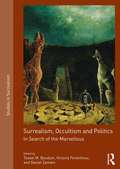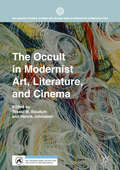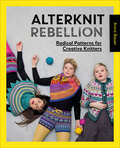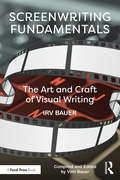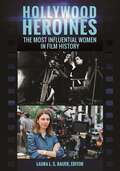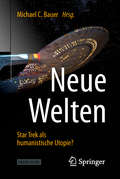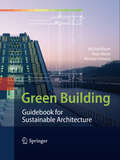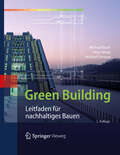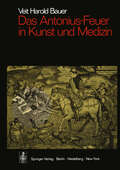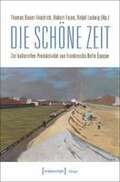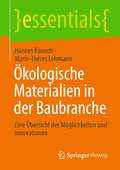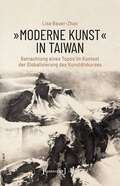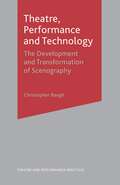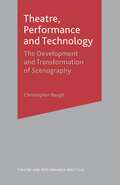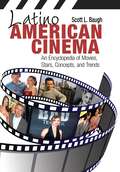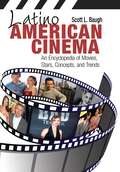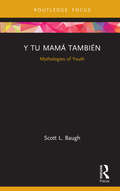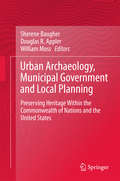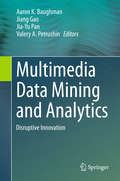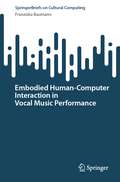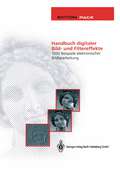- Table View
- List View
Surrealism, Occultism and Politics: In Search of the Marvellous (Studies in Surrealism)
by Tessel M. Bauduin Victoria Ferentinou Daniel ZamaniThis volume examines the relationship between occultism and Surrealism, specifically exploring the reception and appropriation of occult thought, motifs, tropes and techniques by Surrealist artists and writers in Europe and the Americas, from the 1920s through the 1960s. Its central focus is the specific use of occultism as a site of political and social resistance, ideological contestation, subversion and revolution. Additional focus is placed on the ways occultism was implicated in Surrealist discourses on identity, gender, sexuality, utopianism and radicalism.
The Occult in Modernist Art, Literature, and Cinema (Palgrave Studies in New Religions and Alternative Spiritualities)
by Tessel M. Bauduin Henrik JohnssonMany modernist and avant-garde artists and authors were fascinated by the occult movements of their day. This volume explores how Occultism came to shape modernist art, literature, and film. Individual chapters examine the presence and role of Occultism in the work of such modernist luminaries as Rainer Maria Rilke, August Strindberg, W.B. Yeats, Joséphin Péladan and the artist Jan Švankmaier, as well as in avant-garde film, post-war Greek Surrealism, and Scandinavian Retrogardism. Combining the theoretical and methodological foundations of the field of Esotericism Studies with those of Literary Studies, Art History, and Cinema Studies, this volume provides in-depth and nuanced perspectives upon the relationship between Occultism and Modernism in the Western arts from the nineteenth century to the present day.
The Occult in Modernist Art, Literature, and Cinema (Palgrave Studies in New Religions and Alternative Spiritualities)
by Tessel M. Bauduin Henrik JohnssonMany modernist and avant-garde artists and authors were fascinated by the occult movements of their day. This volume explores how Occultism came to shape modernist art, literature, and film. Individual chapters examine the presence and role of Occultism in the work of such modernist luminaries as Rainer Maria Rilke, August Strindberg, W.B. Yeats, Joséphin Péladan and the artist Jan Švankmaier, as well as in avant-garde film, post-war Greek Surrealism, and Scandinavian Retrogardism. Combining the theoretical and methodological foundations of the field of Esotericism Studies with those of Literary Studies, Art History, and Cinema Studies, this volume provides in-depth and nuanced perspectives upon the relationship between Occultism and Modernism in the Western arts from the nineteenth century to the present day.
Alterknit Rebellion: Radical patterns for creative knitters
by Anna BauerA collection of bright, bold and beautiful knitting patterns based on Honsestrikk, a Danish knitting movement from the 1970s which broke away from traditional knitting rules. Honsestrikk, which loosely translates as 'chicken stitch' was influenced by the radical social and political movements of the time, including the women's rights movement, and this can be seen in the personal and political messages of the some of the pattern designs. Instead of the more traditional fair isle colourwork techniques, Honsestrikk knitting featured political messages and motifs, colours clashed and borders butted up against each other in a riot of colour and pattern. Honsestrikk is about knitting in a freer style so you have the freedom to express yourself and create truly unique, personalized garments and accessories. Designer Anna Bauer has been inspired by the Honsestrikk movement to create this collection of basic designs and patterns so you can choose your own combinations and create and knit your own free, radical knits.
Screenwriting Fundamentals: The Art and Craft of Visual Writing
by Irv BauerScreenwriting Fundamentals: The Art and Craft of Visual Writing takes a step-by-step approach to screenwriting, starting with a blank page and working through each element of the craft. Written in an approachable anecdote-infused style that’s full of humor, Bauer shows the writer how to put the pieces together, taking the process of screenwriting out of the cerebral and on to the page. Part One of the book covers character, location, time-frame and dialogue, emphasizing the particularity in writing for a visual medium. Part Two of the book focuses on the narrative aspect of screenwriting. Proceeding incrementally from the idea and story outline, through plotting and writing the treatment, the workshop-in-a-book concludes with writing the First Draft. A unique emphasis on the visual elements of storytelling because the camera is always present—the screenplay must act as a guide for the director and the editor. A "workshop in a book" approach that walks the reader step-by-step through a screenplay—focusing on character, location, time frame, visual components, and transitions—with plenty of exercises that generate material for the narrative writing process. A process-oriented approach, combined with a lighthearted tone and approachable style, that allows the reader to ease into the daunting task of writing a First Draft and takes them all the way through to the end— First Draft in hand.
Screenwriting Fundamentals: The Art and Craft of Visual Writing
by Irv BauerScreenwriting Fundamentals: The Art and Craft of Visual Writing takes a step-by-step approach to screenwriting, starting with a blank page and working through each element of the craft. Written in an approachable anecdote-infused style that’s full of humor, Bauer shows the writer how to put the pieces together, taking the process of screenwriting out of the cerebral and on to the page. Part One of the book covers character, location, time-frame and dialogue, emphasizing the particularity in writing for a visual medium. Part Two of the book focuses on the narrative aspect of screenwriting. Proceeding incrementally from the idea and story outline, through plotting and writing the treatment, the workshop-in-a-book concludes with writing the First Draft. A unique emphasis on the visual elements of storytelling because the camera is always present—the screenplay must act as a guide for the director and the editor. A "workshop in a book" approach that walks the reader step-by-step through a screenplay—focusing on character, location, time frame, visual components, and transitions—with plenty of exercises that generate material for the narrative writing process. A process-oriented approach, combined with a lighthearted tone and approachable style, that allows the reader to ease into the daunting task of writing a First Draft and takes them all the way through to the end— First Draft in hand.
Künste dekolonisieren: Ästhetische Praktiken des Lernens und Verlernens (Wissen der Künste #2)
by Julian Sverre Bauer Maja Figge Lisa Großmann Wilma LukatschDe- und postkoloniale ästhetische Praktiken haben als Interventionen das Kunstfeld nachhaltig verändert und einen wichtigen Beitrag zu postkolonialer Kritik und dekolonialer Theorie-Praxis geleistet. Sie haben Gegen-Narrative und Methoden der Erinnerung entworfen und für die Sicht- und Lesbarkeit hegemonialer Strukturen sensibilisiert. Dennoch ist angesichts der fortgesetzten epistemischen Gewalt die Dekolonisierung der Künste ein unabgeschlossener und umkämpfter Prozess. Die Beiträger*innen des Bandes fokussieren gegenwärtige künstlerische, ästhetische und epistemische Praktiken des Lernens und Verlernens und fragen nach den Konsequenzen dieser Wissenspraktiken für die Kunst- und Kulturwissenschaften, für die Institutionen der Kunst und für die Frage der Vermittlung von Kunst.
Hollywood Heroines: The Most Influential Women in Film History
by Laura L. S. BauerThis is a topical resource that provides a comprehensive look at the most influential women in Hollywood cinema across a wide-range of occupations rarely found together in a single volume.Unlike other anthologies, Hollywood Heroines: The Most Influential Women in Film History is a hybrid of film history and industry information with an exclusive focus on prominent women. This reference work includes more commonly discussed categories of important women in Hollywood film history, such as directors and actresses, and reaches beyond them to encompass women working as cinematographers, casting directors, studio heads, musical composers, and visual and special effects supervisors. The wide range of filmmaking crafts covered in the book provides an acute view of the industry and increases the visibility of and quality of representation for women working in Hollywood. By bringing the experience of these influential women to light, Hollywood Heroines joins a growing movement that endeavors to dismantle harmful, long-standing industry myths that perpetuate the systemic underrepresentation of women and the devaluation of women's stories in the Hollywood film industry.
Neue Welten - Star Trek als humanistische Utopie?
by Michael C. BauerAm 8. September 1966 schrieb die NBC Fernsehgeschichte: An diesem Tag strahlte der US-amerikanische Fernsehsender die erste Folge einer neuen Science-Fiction-Serie aus, mit einer Geschichte über eine außerirdische Lebensform, die Salz zum Überleben braucht und aus Verzweiflung mehrere Mannschaftsmitglieder des Raumschiffes Enterprise ermordet. So recht ahnte bei NBC wohl niemand, dass in diesen 50 Minuten der Grundstein für ein ungeheuer erfolgreiches Science-Fiction-Franchise gelegt wurde: Star Trek. Allein der 50. Geburtstag von Star Trek wäre schon Grund genug gewesen, der Serie eine wissenschaftliche Tagung zu widmen. Noch dazu kommt: Ihrem Erfinder Gene Roddenberry wird nachgesagt, „seine“ Serie nach seinen eigenen humanistischen Überzeugungen geformt, im Star Trek-Universum mithin eine humanistische Utopie verwirklicht zu haben. Aber stimmt das? Ist die Zukunftsvision von Star Trek eine, in der alle humanistischen Ideale erfüllt sind? Eine Welt, in der friedliche Kooperation und die freie Entfaltung aller Individuen die (oft genug auch mörderische) Konkurrenz hinter sich gelassen haben? Diesen und vielen weiteren spannenden Fragen rund um Star Trek gingen die Gäste einer hochkarätigen, interdisziplinären Tagung vom 15. bis 17. April 2016 in Nürnberg nach. Eingeladen hatte der Humanistische Verband Bayern. Der vorliegende Band dokumentiert die Beiträge.
Green Building: Guidebook for Sustainable Architecture
by Michael Bauer Peter Mösle Michael SchwarzAn important consideration for energy-efficient buildings is their primary energy requirements over the entire life cycle. How to determine this? What integrative factors influence the performance of a healthy and sustainable building? This, while it may be important for clients and architects to know, is frequently not very transparent.This book has been written to assist with clarifying target criteria and expanding horizons when it comes to ecological buildings. It is meant as a handbook and source of reference for clients, architects, planners and building operators, to provide them with pertinent information about their design, construction and operation: how to do this in the most energy-efficient and economical manner?Also, there is feedback and documentation about prominent buildings like the Hamburg Dockland or the Landesbank Baden-Wuerttemberg in Stuttgart. They provide excellent architectural examples for detailed construction and design solutions. Further, there are insightful interviews with architects and clients about many important buildings, which help turn this book into an integrated source of reference for sustainable architecture. - A Guideline for Planning, Construction and Operation of sustainable Buildings- A source of reference for clients, architects, planners and building operators- Innovative architectural examples with sustainable concepts and design
Green Building: Leitfaden für nachhaltiges Bauen
by Michael Bauer Peter Mösle Michael SchwarzDer bewährte Leitfaden für das Planen, Bauen und Betreiben von nachhaltigen Gebäuden jetzt in der zweiten AuflageEnergieeffizientes und nachhaltiges Bauen ist heute zur Pflichtaufgabe für Bauherren, Architekten und Planer geworden. Ganzheitliches Wissen zu effizientem Wärmeschutz, innovativen Fassaden, bedarfsgerechten Raumklimasystemen, nachhaltigen Materialien und energie- und ressourcensparenden Energieerzeugungssytemen und Konstruktionen wird erwartet, obwohl am Markt immer noch eher sequentiell und nicht integral gedacht und geplant wird. Dieses Buch soll helfen, die relevanten Einflüsse zu klären und den Blickwinkel für ökologische Gebäude insgesamt zu erweitern. Als Handbuch und Nachschlagewerk liefert es Bauherren, Architekten, Planern, Gebäudebetreibern und Portfolio-Haltern Informationen, wie bei Planung, Bau und Betrieb energieeffizient, wirtschaftlich und strategisch vorgegangen werden kann. Die Dokumentation prominenter Bauten wie die des SPIEGEL-Verlagshauses in Hamburg, des Roche-Bürohochhauses in Basel oder der Deutschen Bank-Türme in Frankfurt liefert architektonisch ansprechende Beispiele und detaillierte Lösungswege. Interviews mit den Architekten und Bauherren vervollständigen das Buch und machen es zu einem umfassenden Standardwerk über nachhaltige Architektur.
Das Antonius-Feuer in Kunst und Medizin (Sitzungsberichte der Heidelberger Akademie der Wissenschaften #1973 / 1973)
by Veit Harold BauerDie schöne Zeit: Zur kulturellen Produktivität von Frankreichs Belle Époque (Image #115)
by Thomas Bauer-Friedrich Robert Fajen Ralph LudwigDie Jahre zwischen 1890 und 1914 werden in Frankreich rückblickend als Belle Époque bezeichnet. Die Beiträge des Bandes beleuchten die außerordentliche kulturelle Produktivität dieses »goldenen Zeitalters« aus unterschiedlichen Perspektiven und rücken die Kunst, Literatur, Musik und Philosophie vor dem Ausbruch des Ersten Weltkrieges in den Mittelpunkt. Dabei beziehen sie sich immer wieder auf die legendäre Sammlung von Arthur und Hedy Hahnloser-Bühler, die bis 2014 in der Villa Flora in Winterthur zu sehen war und die Frankreichs »schöne Zeit« wie in einem Brennglas bündelt.
Ökologische Materialien in der Baubranche: Eine Übersicht der Möglichkeiten und Innovationen (essentials)
by Hannes Bäuerle Marie-Theres LohmannDieses essential zeigt wirksame und innovative Materialbeispiele, die maßgeblich für ein besseres Raumklima eigesetzt werden können und erklärt gleichzeitig, warum ein Umdenken in Richtung Nachhaltigkeit in der Baubranche wichtig ist. Einleitend gibt es einen kurzen Einblick in die Thematik rund um Ökologie und Nachhaltigkeit. Beispielhafte Materialien unterschiedlicher Bereiche und Möglichkeiten der Entsorgung werden aufgeführt. Zudem wird eine denkbare Zukunft im Baubereich fokussiert. Somit bietet das essential einen informativen Rundumblick in die Welt des nachhaltigen Bauens.
»Moderne Kunst« in Taiwan: Betrachtung eines Topos im Kontext der Globalisierung des Kunstdiskurses (Image #178)
by Lisa Bauer-ZhaoWas ist »moderne Kunst«? Aus der Perspektive des taiwanischen Kunstdiskurses gestellt, macht diese Frage Diskrepanzen in der Erzählung der Kunstgeschichte der Moderne sichtbar, die von Europa aus weitestgehend unbeachtet bleiben. Anhand von taiwanischen kunstkritischen Texten seit den 1950er Jahren - die hier das erste Mal in deutscher Übersetzung vorgelegt werden - analysiert Lisa Bauer-Zhao das Verständnis von moderner Kunst, dessen Veränderung sowie die zugehörige Begriffsgeschichte in Taiwan. Im Kontext der Globalisierung der Kunstwelt beleuchtet sie die aufscheinenden Problemfelder und eröffnet eine globale Perspektive auf die Diskussion um moderne Kunst.
Theatre, Performance and Technology: The Development and Transformation of Scenography (Theatre and Performance Practices)
by Christopher BaughChris Baugh explores how developments and changes in technology have been reflected in scenography throughout history. Taking into account the latest research, his new edition examines moving light technologies, the internet as a platform of performance, urban scenography and how scenography has developed as a collaborative practice.
Theatre, Performance and Technology: The Development and Transformation of Scenography (Theatre and Performance Practices)
by Christopher BaughChris Baugh explores how developments and changes in technology have been reflected in scenography throughout history. Taking into account the latest research, his new edition examines moving light technologies, the internet as a platform of performance, urban scenography and how scenography has developed as a collaborative practice.Chris Baugh explores how developments and changes in technology have been reflected in scenography throughout history. Taking into account the latest research, his new edition examines moving light technologies, the internet as a platform of performance, urban scenography and how scenography has developed as a collaborative practice.
Latino American Cinema: An Encyclopedia of Movies, Stars, Concepts, and Trends
by Scott L. BaughLatino American cinema is a provocative, complex, and definitively American topic of study. This book examines key mainstream commercial films while also spotlighting often-underappreciated documentaries, avant-garde and experimental projects, independent productions, features and shorts, and more.Latino American Cinema: An Encyclopedia of Movies, Stars, Concepts, and Trends serves as an essential primary reference for students of the topic as well as an accessible resource for general readers. The alphabetized entries in the volume cover the key topics of this provocative and complex genre—films, filmmakers, star performers, concepts, and historical and burgeoning trends—alongside frequently overlooked and crucially ignored items of interest in Latino cinema. This comprehensive treatment bridges gaps between traditional approaches to U.S.-Latino and Latin American cinemas, placing subjects of Chicana and Chicano, Puerto Rican, Cuban and diasporic Cuban, and Mexican origin in perspective with related Central and South American and Caribbean elements. Many of the entries offer compact definitions, critical discussions, overviews, and analyses of star artists, media productions, and historical moments, while several foundational entries explicate concepts, making this single volume encyclopedia a critical guide as well.
Latino American Cinema: An Encyclopedia of Movies, Stars, Concepts, and Trends
by Scott L. BaughLatino American cinema is a provocative, complex, and definitively American topic of study. This book examines key mainstream commercial films while also spotlighting often-underappreciated documentaries, avant-garde and experimental projects, independent productions, features and shorts, and more.Latino American Cinema: An Encyclopedia of Movies, Stars, Concepts, and Trends serves as an essential primary reference for students of the topic as well as an accessible resource for general readers. The alphabetized entries in the volume cover the key topics of this provocative and complex genre—films, filmmakers, star performers, concepts, and historical and burgeoning trends—alongside frequently overlooked and crucially ignored items of interest in Latino cinema. This comprehensive treatment bridges gaps between traditional approaches to U.S.-Latino and Latin American cinemas, placing subjects of Chicana and Chicano, Puerto Rican, Cuban and diasporic Cuban, and Mexican origin in perspective with related Central and South American and Caribbean elements. Many of the entries offer compact definitions, critical discussions, overviews, and analyses of star artists, media productions, and historical moments, while several foundational entries explicate concepts, making this single volume encyclopedia a critical guide as well.
Y Tu Mamá También: Mythologies of Youth (Cinema and Youth Cultures)
by Scott L. BaughCharting production, distribution, censorship, and reception, this book examines Y Tu Mamá También in its presentation as a journey of self-discoveries. Three young adults enjoy a road trip together in search of a legendary beach. Behind their stories are mythologies of youth, a network of ideas in the film that reflects life outside the theaters. The deceptively complex film leaves the characters and its viewers with, instead of oversimplified and hollow answers, provocative questions and existential concerns. Made independently in Mexico, the film crosses over transnational issues, global markets, and mainstream and alternative aesthetics. It transforms road movie and youth film genres and shows a ‘musical, magical’ Mexico to the world. This book synthesizes several approaches in order to extensively examine Y Tu Mamá También. Covering the film’s production history, its distribution and censorship, and larger industrial, political, and cultural contexts, this book analyzes the too-often overlooked aspects of youthful sexuality alongside figurations of maturity, rites of passage, and covenants—made, broken, and remade—that not only inform representations of identity but also complicate the processes of identity formation themselves.
Y Tu Mamá También: Mythologies of Youth (Cinema and Youth Cultures)
by Scott L. BaughCharting production, distribution, censorship, and reception, this book examines Y Tu Mamá También in its presentation as a journey of self-discoveries. Three young adults enjoy a road trip together in search of a legendary beach. Behind their stories are mythologies of youth, a network of ideas in the film that reflects life outside the theaters. The deceptively complex film leaves the characters and its viewers with, instead of oversimplified and hollow answers, provocative questions and existential concerns. Made independently in Mexico, the film crosses over transnational issues, global markets, and mainstream and alternative aesthetics. It transforms road movie and youth film genres and shows a ‘musical, magical’ Mexico to the world. This book synthesizes several approaches in order to extensively examine Y Tu Mamá También. Covering the film’s production history, its distribution and censorship, and larger industrial, political, and cultural contexts, this book analyzes the too-often overlooked aspects of youthful sexuality alongside figurations of maturity, rites of passage, and covenants—made, broken, and remade—that not only inform representations of identity but also complicate the processes of identity formation themselves.
Urban Archaeology, Municipal Government and Local Planning: Preserving Heritage within the Commonwealth of Nations and the United States
by Sherene Baugher Douglas R. Appler William MossImproving the relationship between archaeology and local government represents one of the next great challenges facing archaeology –specifically archaeology done in urban settings. Not only does local government have access to powerful legal tools and policy mechanisms that can offer protection for privately owned archaeological sites, but because local government exists at the grassroots level, it is also often closer to people who have deep knowledge about the community itself, about its values, and about the local meaning of the sites most in need of protection. This partnership between archaeology and local government can also provide visibility and public programing for heritage sites. This book will explore the experiences, both positive and negative, of small and large cities globally. We have examined programs in the Commonwealth of Nations (formerly known as the British Commonwealth) and in the United States. These countries share similar perspectives on preservation and heritage, although the approaches these cities have taken to address municipal archaeology reveals considerable diversity. The case studies highlight how these innovative partnerships have developed, and explain how they function within local government. Engaging with the political sphere to advocate for and conduct archaeology requires creativity, flexibility, and the ability to develop collaborative partnerships. How these archaeological partnerships benefit the community is a vital part of the equation. Heritage and tourist benefits are discussed. Economic challenges during downturns in the economy are analyzed. The book also examines public outreach programs and the grassroots efforts to protect and preserve a community's archaeological heritage.
Multimedia Data Mining and Analytics: Disruptive Innovation
by Aaron K. Baughman Jiang Gao Jia-Yu Pan Valery A. PetrushinThis book provides fresh insights into the cutting edge of multimedia data mining, reflecting how the research focus has shifted towards networked social communities, mobile devices and sensors. The work describes how the history of multimedia data processing can be viewed as a sequence of disruptive innovations. Across the chapters, the discussion covers the practical frameworks, libraries, and open source software that enable the development of ground-breaking research into practical applications. Features: reviews how innovations in mobile, social, cognitive, cloud and organic based computing impacts upon the development of multimedia data mining; provides practical details on implementing the technology for solving real-world problems; includes chapters devoted to privacy issues in multimedia social environments and large-scale biometric data processing; covers content and concept based multimedia search and advanced algorithms for multimedia data representation, processing and visualization.
Embodied Human–Computer Interaction in Vocal Music Performance (Springer Series on Cultural Computing)
by Franziska BaumannThis SpringerBrief provides a unique insight into the practice and research of the connections between voice, HCI and embodiment. Specifically, it explores how the voice can be embodied and mediated by means of gestural communication through sensor interfaces and aims to situate and contextualise various aspects that generate meaningful connections in such interactive interface performance. The author offers an approach for understanding creative practices between humans and computers in gestural live music performance, from the perspective of the embodied relationships created within such systems. Underlying practices, principles and sensor technologies that support creativity in embodied human-computer interaction in vocal music performance are examined and a dynamic framework and tools for anyone wishing to engage with this subject in depth are presented. The book is essential reading not only for musicians, composers, researchers, application developers, musicologists and educators but also for students and tertiary institutions as well as actors and dramaturgs in a music context.
Handbuch digitaler Bild- und Filtereffekte: 1500 Beispiele elektronischer Bildbearbeitung (Edition PAGE)
by Hans D. BaumannWerbegrafiker, DTPler, Fotografen und alle, die Abbildungen und Illustrationen mit dem Computer herstellen, benutzen Mal- und Retuscheprogramme. Diese Programme enthalten eine große Zahl von Werkzeugen (Filter), mit deren Hilfe es möglich ist, Bilder und Fotos in unterschiedlichster Weise zu erzeugen, zu bearbeiten und zu verfremden, deren Anwendung jedoch umfangreiche Spezialkenntnisse voraussetzt. Das Buch erklärt anhand zahlreicher Illustrationen (teilweise farbig), wie diese Werkzeuge effektiv benutzt werden und welche Ergebnisse man mit welchen Einstellungen erhalten kann. Die Darstellung ist programmübergreifend. Dadurch ist es möglich, gezielt die gewünschten Effekte und Programme zu finden und anzuwenden. Für Macintosh und Windows!
